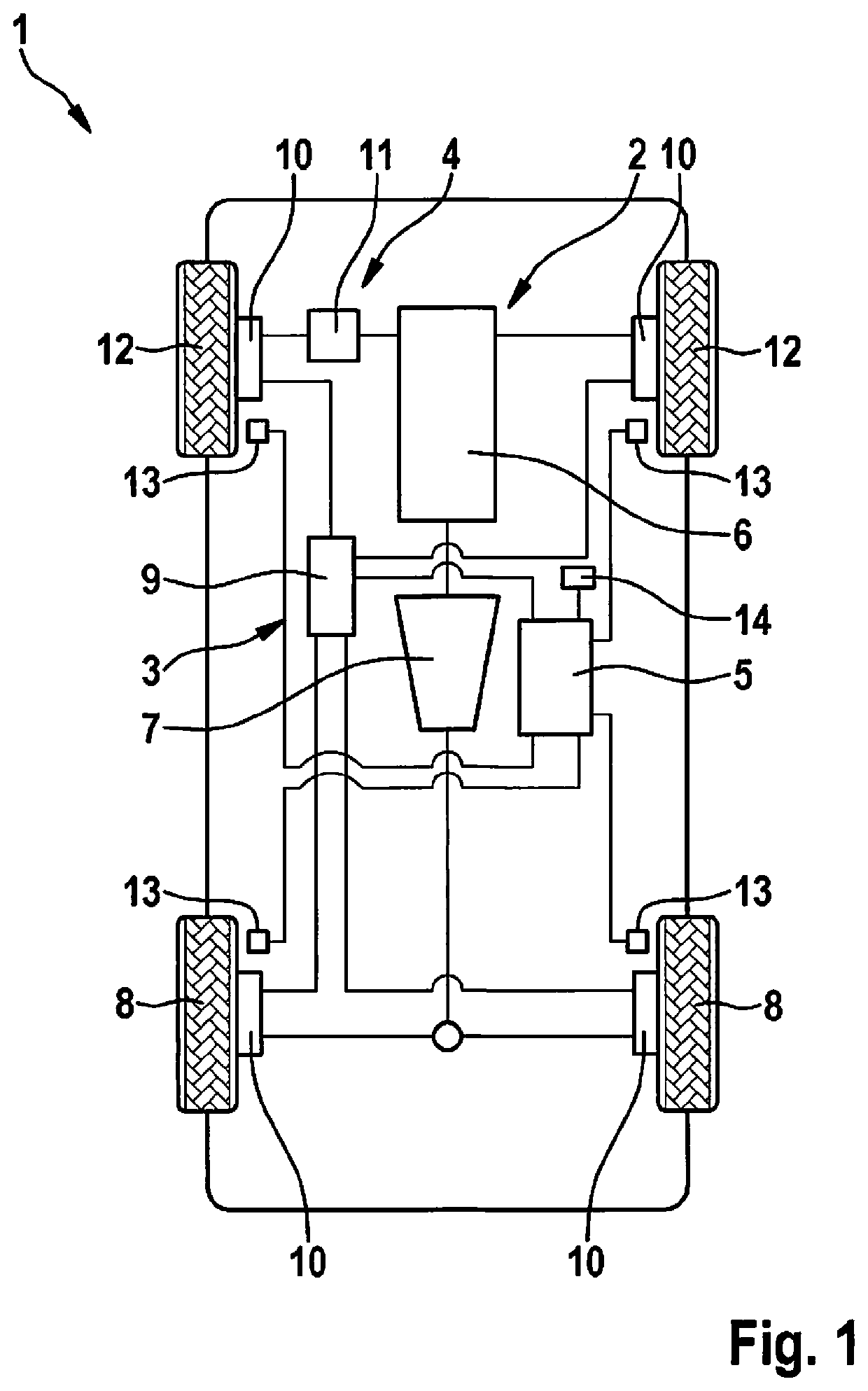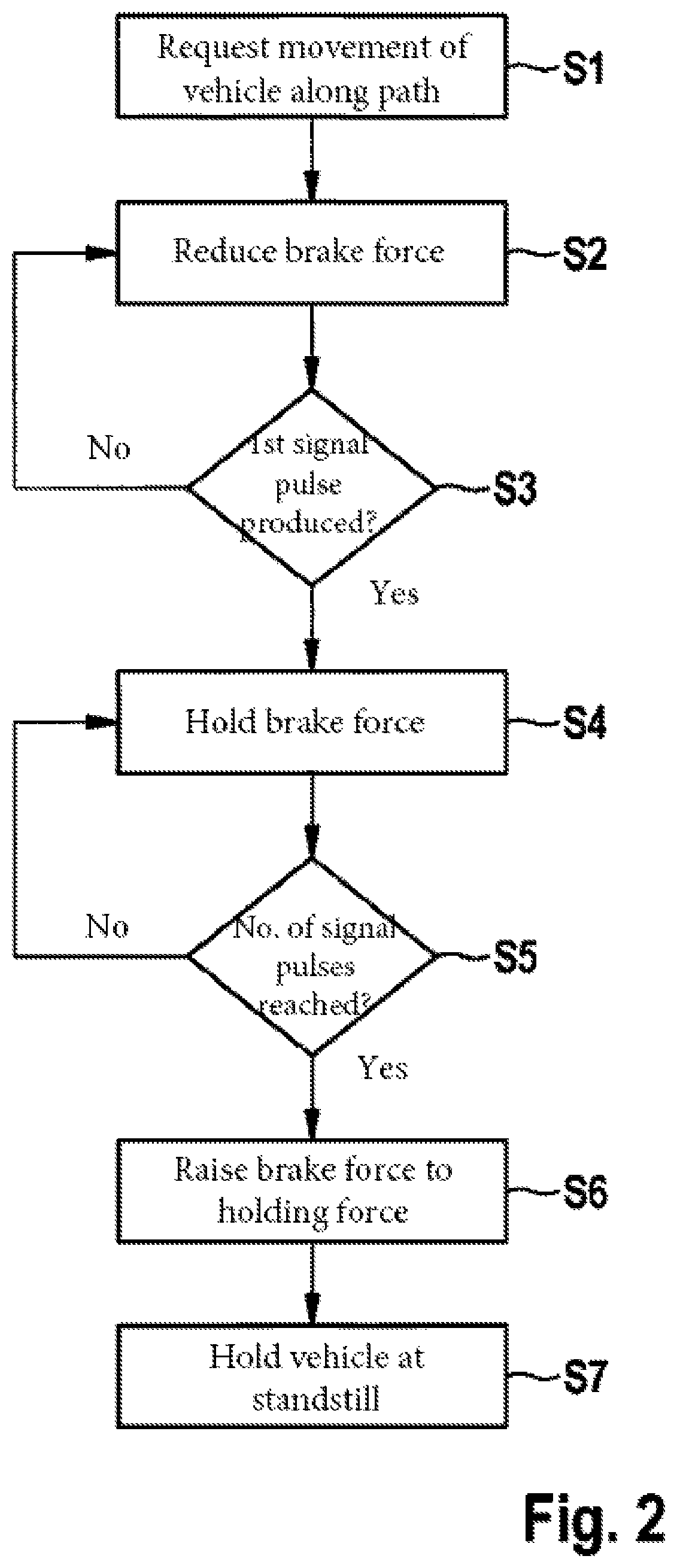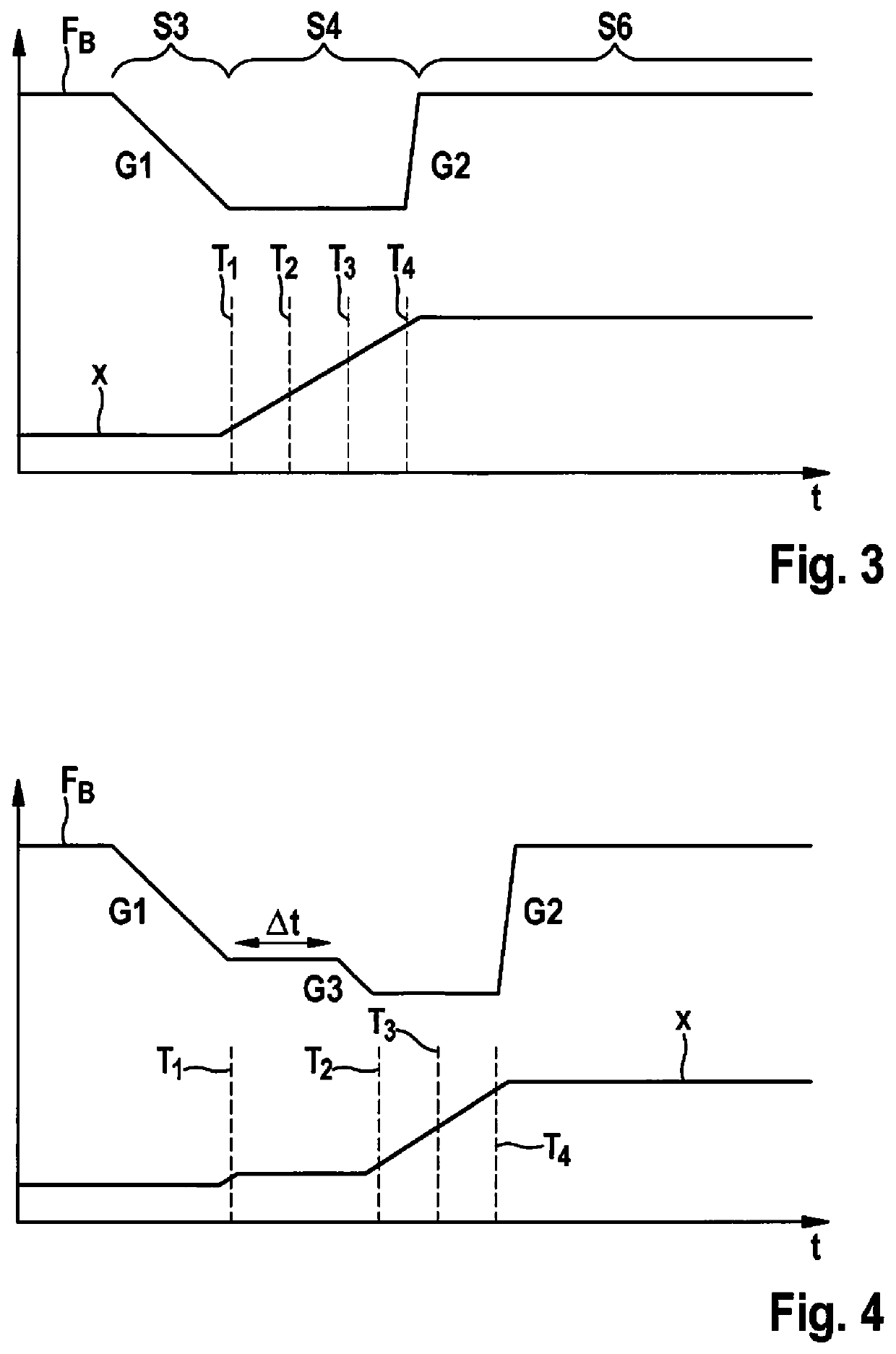[0006]The method according to the present invention having the features described herein has the advantage that the signal pulses of the one, or the plurality of, rotational speed sensors are used to carry out a short path driving process. Here the method according to the present invention makes it possible, despite a short driving path and the associated low driving speed, to reliably track the movement of the motor vehicle and thus to safely and reliably carry out the short path driving maneuver. According to the present invention, for this purpose it is provided that, in the case of a short path driving process as a specifiable driving maneuver starting from the stationary state, the braking force is first reduced until the rotational speed sensor produces a first signal pulse, and is then held at least temporarily constant until a specified number of signal pulses has been produced, and subsequently is increased up to the holding force. The present invention thus provides that to carry out a short path driving process the number of signal pulses is used for the actuation of the brake system and thus for the delimitation and setting of the traveled path. To this extent, a short path driving process is understood in particular as a parking maneuver, or entering or leaving a parking place, in which, in particular, only speeds below 20 km / h, in particular below 10 km / h, occur. To carry out the driving process, first the braking force is reduced. As soon as a first signal pulse is produced by a, or the, rotational speed sensor, the current brake force is held constant. Here it is assumed that at this braking force a low travel speed is reached that causes the wheels to roll, but that a further acceleration is at least largely prevented by the brake force held constant. Subsequently, the further signal pulses produced by the rotational speed sensor are counted and, as a function of the counted signal pulses, the driving process is ended by increasing the holding force as soon as a specified number of signal pulses has been produced. Because the number of signal pulses per rotation of a wheel is known, and the distance of the signal pulses from one another is also known, the traveled path can be easily and precisely determined or calculated as a function of the acquired number of signal pulses. The traveled path is thus first converted into the number of signal pulses to be produced as a function of the signal pulses per rotation of a wheel and of the wheel outer diameter, and subsequently, when the specified or calculated number of signal pulses has been reached, the braking force is again increased up to the holding force, which securely prevents rotation of at least one of the wheels, in order to bring the wheels of the vehicle again to a standstill and to end the driving maneuver. In this way, the destination point of the driving maneuver is safely reached.
[0007]According to an exemplary embodiment of the present invention, the number of signal pulses is specified as a function of a path to be traveled, as mentioned above. Here, in particular the outer diameter of the wheel, and the number of pulses per rotation of this wheel, are taken into account. In this way, an unambiguous tracking of the movement of the motor vehicle is ensured and the driving maneuver can be carried out precisely.
[0011]According to a specific embodiment of the present invention, it is provided that the drive torque is produced before the brake force is reduced. This has the advantage that the motor vehicle is tensioned, or pre-tensioned, while at a standstill, and rolling back of the motor vehicle when the braking force is reduced is reliably prevented. In this way, the robustness of the driving function, or of the short path driving maneuver, is increased. As already mentioned, here as well the drive torque may be set as a function of the current roadway slope in order to reliably prevent the rolling back. In particular, the drive torque is taken back or reduced only upon reaching the last signal pulse of the specified number of signal pulses, so that a uniform driving movement of the motor vehicle up to the reaching of the destination position is insured, and in particular the motor vehicle is prevented from coming to a standstill prematurely, before reaching the target position.
[0012]According to an exemplary embodiment of the present invention, it is provided that a plurality of, in particular all, the wheels of the motor vehicle are each assigned a rotational speed sensor, and that the brake force is held constant and / or increased only when a signal pulse has been produced by at least two of the rotational speed sensors. In this way, the robustness of the method is further increased, because for example in the case of a bouncing of a signal pulse, for example if the motor vehicle is moving very slowly and the rotational speed sensor stands at the threshold of a signal pulse for a long time, a beginning movement of the motor vehicle is nonetheless robustly ascertained. In particular, the braking force is held constant or increased only when a first signal pulse has been produced by each of the rotational speed sensors.
[0013]In addition, it may be provided that a rotational speed sensor is assigned to each of a plurality, in particular all, of the wheels, and that the drive torque is not reduced until a first signal pulse has been produced by at least two, in particular by all, rotational speed sensors. In this way, it is ensured that at the beginning of the driving maneuver the motor vehicle is set into movement as a whole, and the counting of the signal pulses reliably leads to the specified destination. For the case in which the path to be traveled is not divisible by the signal pulses without a remainder, then in a further specific embodiment a whole-number rounding may be carried out. In particular, the number of signal pulses is rounded down, so that in this way the probability is increased that the traveled path never goes beyond the requested path. In this way, the safety of the driving function is increased because the probability of a collision, and in particular driving past the destination, decreases. The increasing of the braking force may be introduced with the next-to-last signal pulse of the number of signal pulses to be acquired, in order to at least approximately compensate the path additionally traveled during the braking process resulting from the blind travel before the first signal pulse when starting. In this way, the reaching, or traveling, of the requested path length is further improved.
 Login to View More
Login to View More  Login to View More
Login to View More 


